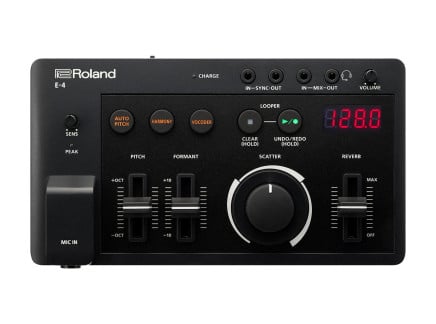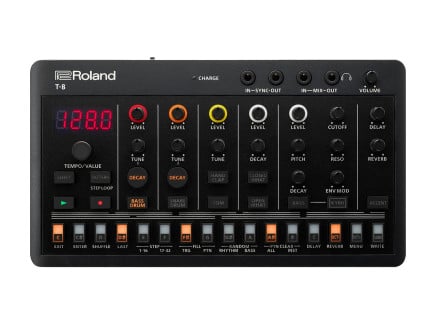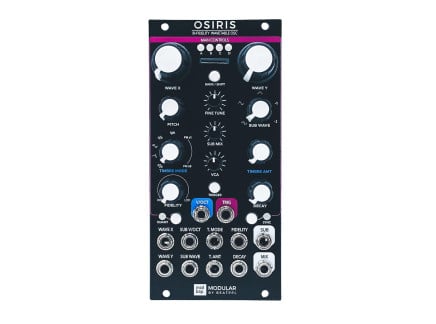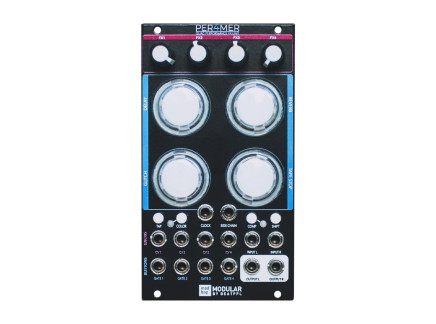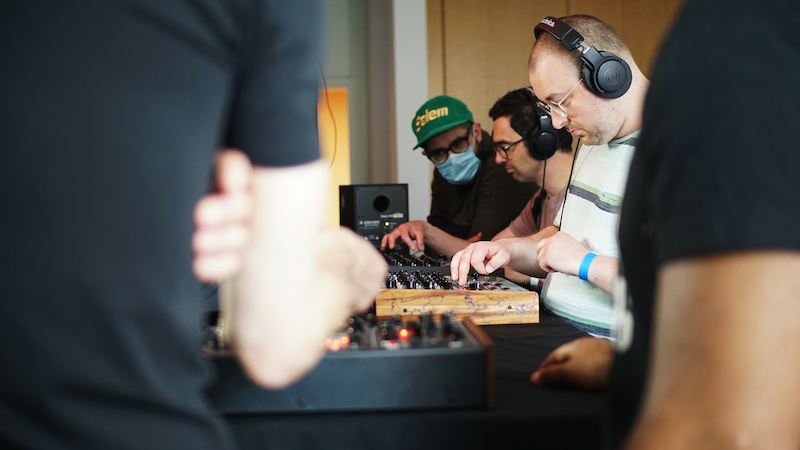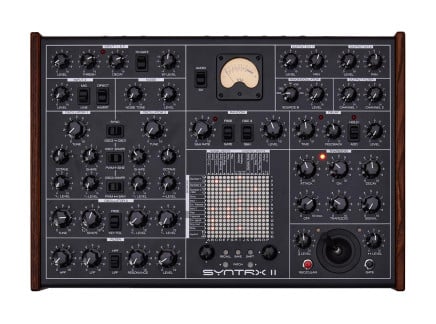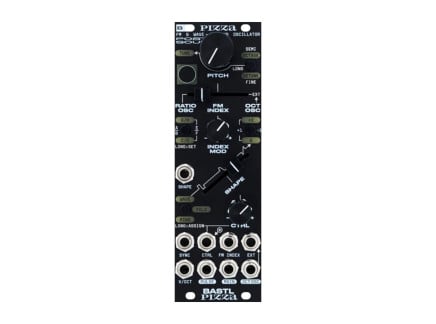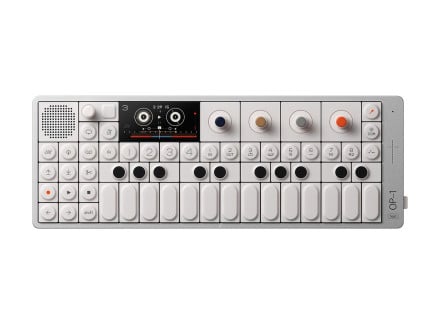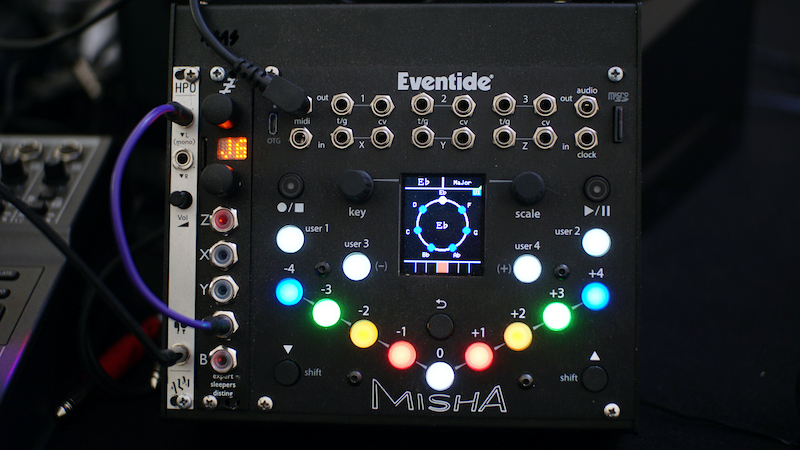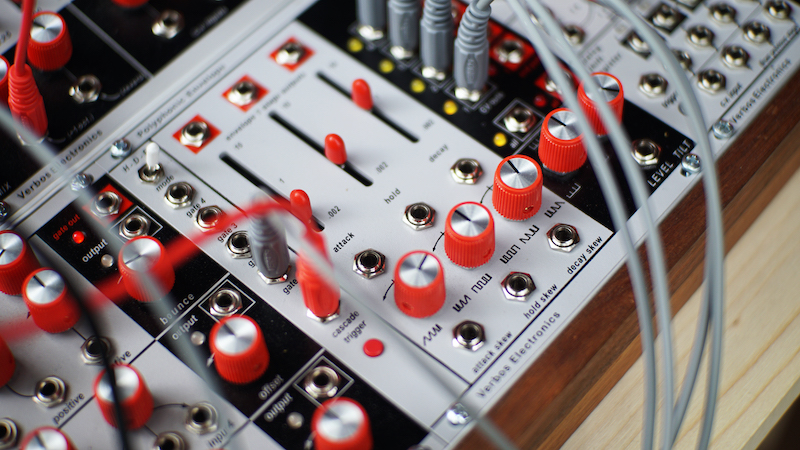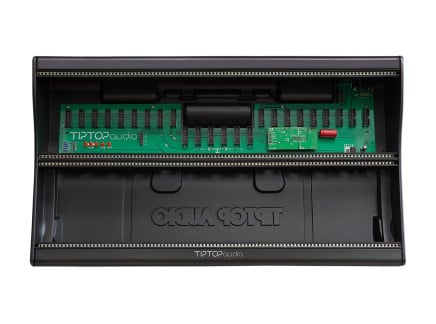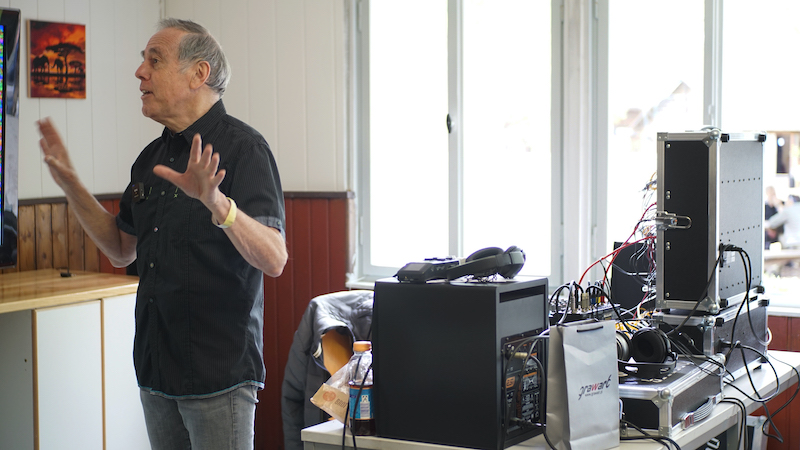It's that time of year again. Superbooth is underway, and you should know what that means: many of the world's most interesting electronic musical instrument designers are gathering in Berlin to show their newest devices and peculiar sonic inventions. From new Eurorack modules to forward-thinking drum machines, effect processors, and more...it's all there, and by Jove is there a lot to talk about.
It seems that every Superbooth turns up a ton of inspiring new gear, both from exhibitors at the show as well as others who couldn't make it out to Berlin. So we're using this space to document all of the most exciting new releases that we can—whether or not the designers have a booth in Berlin. We're there in person, and we'll keep updating this article as we discover more and more exciting new gear; so keep your eyes here for fresh news throughout the show.
Here's what we know so far.
Oberheim is Back: the OB-X8
Let's start with the big—and I mean big—news...Oberheim has officially returned to the synth business, with their first all-new design in 35 years: the OB-X8. OB-X8 is an eight-voice analog synthesizer with bi-timbral capability, faithfully recreating all of the behavior of the OB-X, OB-8, and OB-Xa. That's right, it's three of the best synthesizers of all time rolled into a single package, with tons of added modern conveniences—and that's about the strongest re-entry into the synth business as we can imagine.
OB-X8 brings the real sound of these classic instruments to a whole new level. The signal path starts with two discrete OB-X oscillators per voice; the oscillators feature sine, triangle, saw, and square shapes. Additionally, they offer PWM, cross modulation, and hard sync options, sure to provide a huge range of deep, raw sounds to work with. The signal passes to a multi-mode filter section full of sonic delights. The filter section features a SEM/OB-X lineage discrete filter—and like the SEM, it offers lowpass, highpass, bandpass, and notch filter options. You also have the option to engage a Curtis filter...evoking the sound of the OB-8 and OB-Xa. From there, the signal passes to a final VCA.
In terms of modulation, the OB-X8 sports dedicated filter and amp ADSR envelopes with dedicated front panel controls; the filter ADSR can also be used to modulate oscillator 1's frequency, particularly helpful with patches that make use of hard sync. The LFO features multiple shapes (including sine, square, saw, ramp, and sample & hold), and can be assigned to multiple destinations, from oscillator pitches to filter cutoff, per-oscillator PWM, and the VCA's overall volume level.
All eight voices can be used together in Unison mode to create planet-crushingly huge leads and bass sounds. Detuning the second oscillator in such patches will take you a long way—but there's more to it than just that. Manufactured in collaboration with Sequential, the OB-X8 borrows the "Vintage" knob first seen on the reissued Prophet-5 and Prophet-10, allowing for continuously variable voice-to-voice inconsistencies. This can range from subtle detuning all the way to quite striking differences in behavior from voice to voice, creating everything from charming inconsistencies to swarming, breathing unison tones. Combine this with the ability to determine each voice's position in the stereo field and...geez, the possibilities seem endless.
But that's not all—the OB-Xa also features an integrated arpeggiator, classic Oberheim pitch and modulation levers (with dedicated modulation LFO), a chord mode, and a Fatar keybed that offers both velocity and channel aftertouch...great for adding expressive inflection to your filters and loudness. Additionally, rear-panel MIDI connections, external control inputs, a modernized power supply, extensive preset memory, and—oh yeah—bi-timbral splits and layers make this not only one of the best-sounding Oberheim synths of all time, but one of the most capable and convenient as well. If you've ever thought about getting an Oberheim, there's no reason that I wouldn't pick the OB-X8: for many, it's a synth that's been decades in the making, and it's finally real.
Curious to learn more? Check out our in-depth article about the OB-X8 here.
Roland's Aira Compact Series
Ahead of Superbooth, Roland has announced the release of the new Aira Compact Series: a trio comprised of a compact drum machine, synthesizer, and effect processor. These have a distinctly Volca-like appearance, but they're no rip-off—these devices present streamlined takes on some of Roland's most interesting gear across the years, from the TR Series drum machines and Juno synthesizers to the peculiar lineage of the VT-1 Voice Transformer. Like Volcas, though, they come in at an astoundingly affordable price. They also feature an internal battery, inter-device analog sync, MIDI I/O via 3.5mm jacks, MIDI and audio via USB-C, and the ability to daisy-chain audio...so if you've got all three, you have a portable music production setup to reckon with. Let's take a look at what they each have to offer.
The Aira Compact T-8 Beat Machine is a rhythm and bass machine. It features six drum voices inspired by the classic 808, 909, and 606, as well as a bass synth voice designed to emulate the sounds of the squelchy, sought-after TB-303. Using Roland's acclaimed Analog Circuit Behavior technology, they nail the sound of the originals—and so, together, that makes for an instrument that can carry its own for full solo performances. Simply use the TR-REC sequencer to create, chain, and live-manipulate sequences while the live delay, reverb, and sidechain compression/overdrive keep your mix glued together. Frankly, it's amazing that Roland put so much into this tiny box, and we expect that it'll make a great entry into the world of music-making for many eager musicians. Honestly, it sounds great, and the feature set is surprisingly well-thought-out for the price.
The Aira Compact J-6 Chord Synthesizer is a pint-sized repackaging of the iconic Juno-60, designed to make it simple for folks of any musical background to lay down rich, lush, compelling pads and stabs. An excellent complement to the aforementioned T-8 Beat Machine, the J-6 can easily add harmony to your performances and productions. Using genre-based banks of eight chords each, you can get started laying down harmonies straight away, even without having a background in "traditional" music theory. Combine this with the integrated sequencer, arpeggiator, and all the MIDI and sync functionality from the rest of the Aira Compact series, and you've got a synthesizer that's ready to add depth and movement to any setup at any budget.
And then, there's the odd one of the bunch: the E-4 Voice Tweaker, the newest descendant of the iconic and peculiar VT-1 Voice Transformer. The original Voice Transformer is sought-after to this very day, prized for its quirky flavor of pitch shifting, formant shifting, and robotic vocal effects. The Voice Tweaker handles all of this territory and much more, adding the option for auto-tune style tuning correction, harmonization, vocoding, looping, and more. It also includes a large, front-and-center Scatter knob—providing everything from tempo-synced glitches and auto-panning to filtering, bitcrushing, and much more. E-4 will be great for processing any sound (perhaps even the sound of the other Aira Compact units?), but we expect it'll eventually take its place in history as yet another highly peculiar vocal processor: a one-stop-shop for vocal manipulation, mangling, and surreal sonic fun. We're particularly excited about this one.
Despite their price and appearance, these units are quite deep—and we're excited to dive in as soon as they're available. If you're curious to learn more, check out our in-depth article on the Aira Compact Series here.
Cre8audio East Beast Semi-Modular Synthesizer
Cre8audio's newest instrument is a collaboration with one of our long-standing favorite Eurorack companies: Pittsburgh Modular, with creative designers/thinkers Richard Nicol and Michael Johnsen at the helm. Together, they've created the East Beast, a desktop semi-modular instrument that brings East Coast-style modular synthesis to the masses. Frankly, the price of the East Beast is a bit befuddling—this is a lot of synth for the price, and we think it's going to be a huge hit for seasoned synthesists and newcomers to the hobby.
It's worth mentioning that Pittsburgh is no stranger to producing desktop semi-modular instruments; from the old-school Patch Box to the Microvolt 3900 and Voltage Research Lab, they've consistently designed some of the most excellent-sounding and fun contributions to that form factor altogether. The same is true of the East Beast...and given their track record, we're sure that this is going to prove to be an amazing instrument.
East Beast is a desktop semi-modular synth with the core tenets of East Coast synthesis at its heart: it uses a beefy-sounding sawtooth-core oscillator running through a fully analog filter with "Zero Dead Spots." The oscillator is fairly straightforward, offering classic waveshapes (sine, triangle, saw, pulse) with the option for glide, linear FM, and PWM. Pittsburgh has consistently designed amazing filters, and based on what we've heard, the filter in East Beast is no exception—if anything, it's a striking development that builds upon the successes of their prior designs. With rich, round lowpass, fizzy highpass, and biting bandpass responses, it's capable of shaping the core oscillator in a vast number of ways. As you might expect, East Beast also offers a VCA, ADSR, and LFO—all the core parts of a classic East Coast synth in a compact package.
East Beast also features a flexible controller section: a button-style black and white keyboard with options for sequencing, arpeggiation, MIDI-CV conversion, random voltage generation, and much more. And of course, the instrument as a whole opens up considerably when employing the patch bay: while it does feature a normalled signal path behind the panel for easy access to classic synth sounds, the true power becomes apparent when using the patch bay to override these routings and customize its behavior to your heart's content. Moreover, East Beast can even be removed from its included enclosure and added to a Eurorack system—so when you're ready to expand, it can come right along with you.
If you're curious to learn more, be sure to check out our in-depth East Beast article as well!
Reverb-Like Spectral Effects for Eurorack: Qu-Bit's Aurora
Qu-Bit has made something of a routine of bringing abstract and obscure new synthesis techniques to Eurorack modular synthesis. Borrowing from the likes of computer music journals and conference proceedings, they've realized a vast array of modules that have expanded the sonic palette of synthesizers altogether, from the ever-popular Nebulae to the more recent Scanned and beyond.
Today, Qu-Bit has announced the impending availability of Aurora: their stereo spectral reverb. We first heard about Aurora at NAMM in 2020—but judging by its final feature set and sound, it's well worth the wait.
Rather than using simple delay lines and filtering to create the illusion of a large sonic space, Aurora takes a different approach entirely: it uses a phase vocoding engine in order to provide maximal independent control of your sounds' frequency and time components. That might sound fairly abstract...so in practical terms, it means that Aurora allows you to blur, smear, warp, and otherwise mangle your input sounds using advanced synthesis methods previously difficult to find in hardware form.
Aurora specializes at reverb—turning any input sound into a vast, decaying, evolving soundscape. But it can go much farther than that: it can timestretch and freeze incoming audio; it can shift your spectral content; it can create twinkling multi-tap delay tones; it can add atmospheric filtering; it can reverse—and it can do all of this under voltage control. It can even offset incoming spectral information in 1V/oct scaling, meaning that you can create reverb that generates counterpoint with the sounds that seed it...whoa.
If you're feeling confused, that's okay: Aurora truly is an unprecedented type of hardware audio effect, and we suspect that all of its uses won't be quite clear until we've gotten our hands (and our modulation sources!) on every parameter. Suffice to say that this is perhaps one of the most interesting Eurorack reverbs out there, and we strongly suspect that it will prove to do much more than the word "reverb" alone can begin to cover. If you're an adventurous synthesist or a sound designer looking for additional uncharted sonic territory...you'll want to get an Aurora ASAP.
If you're interested to learn more, be sure to check out our dedicated in-depth article on the Aurora!
Korg Nu:Tekt NTS-2—an Invaluable Educational Resource
Something of a surprise, Korg has released the newest in their Nu:Tekt series: the NTS-2, a four-channel oscilloscope and dual function generator. The Nu:Tekt line is a series of DIY tools for electronic musicians...and this one is particularly exciting for those diving into the world of modular synthesis, and frankly...for basically anyone else interested in analog synthesizers, period.
NTS-2 is an easy-to-use four-channel oscilloscope with a bright, colorful display and simple user interface. You can use it to visualize up to four signals at a time—invaluable for decoding exactly what's going on in your synthesizer. Use it to visualize audio or control signals, and soon, the aspects of your instrument that may seem mysterious at first will become clear. If you're just starting out with modular synthesis, this can be a tremendous tool for breaking through some of the more complex aspects of synthesis: somehow, being able to visualize what's happening is sometimes all it takes for new concepts to "click."
But NTS-2 is more than just that—it also features an FFT-based spectral display (great for understanding all sorts of aspects of your sound), as well as a multi-mode tuner for getting your synths easily in tune. Additionally, it includes a two-channel function generator—capable of generating LFOs, noise, pulses, and more for use within your modular system of choice.
NTS-2 ships bundled with the newest release from Bjooks, Patch and Tweak with Korg: a guide book for synthesis focused around some of Korg's most popular modern instruments, including the Volca Modular, MS-20 Mini, ARP 2600 M, SQ-1, and SQ-64. So if you're taking your first steps in to synthesis—especially if you're doing so with one of these particular instruments—we have to imagine that this bundle will prove an excellent complement to your budding synthesis journey.
Look Mum No Computer: #1222 Performance VCO
Look Mum No Comupter has entered the Eurorack sphere with the #1222 Performance VCO: a Eurorack oscillator designed for a raw, quirky sound with a number of niceties for studio and live performance use.
Look Mum No Computer has been designing synthesizer modules for a while, in his own Kosmo format: a DIY synthesizer format with 5U panels, 1/4" jacks, and standard Eurorack power and signal level specifications. Starting in 2020, he began releasing PCB + panel kits for his Kosmo modules, providing a powerful, quirky, and affordable way for countless people to get into the weird world of modular synthesis. The #1222 Performance VCO is based on a Kosmo module of the same name, but it is in fact a standard Eurorack module...ready to play with all the other pieces of your system.
#1222 Performance VCO is a no-nonsense analog oscillator with square, saw, and triangle waveshape outputs. It offers FM, hard sync, pulse width modulation, all creating raw, intense sounds authentic to its Kosmo format origin. However, some of the more special aspects of this design have to do with its tuning functions: it features a large front-panel octave switch and a fine-tune knob with a one-octave range. Coupled with an onboard seven-segment LED display that shows you what note you're playing and whether it's sharp, flat, or in tune, this makes it downright simple to get your synthesizer in tune every time. I can imagine this will prove particularly useful if you're using multiple of this oscillator in a single system—it'd be quite easy to dial in chords, clusters, unisons, and all sorts of harmonic delights.
If you want to learn more, be sure to check out our in-depth article on the LMNC #1222 performance VCO!
Befaco AC/DC: a New Eurorack Audio Interface
Befaco and Rebel Technology are at it again: providing a powerful utility that could easily benefit any modular system we can imagine. This time, they've created AC/DC, a 4x4 USB audio interface optimized for use with Eurorack modular systems.
If you're familiar with the Expert Sleepers ES-8, the AC/DC should be quite straightforward: it's a 4-input, 4-output audio interface for Eurorack synthesizers. It offers up to 48kHz, 16-bit operation, with all inputs and outputs supporting up to +/-10V signal levels. What's more—it's fully DC-coupled, meaning that it can easily be used to send low-frequency modulation signals into and out from your computer. While its output channel count is lower than the ES-8's, it does include some additional niceties: each input features a dedicated signal level control and clipping indicator LEDs, making it quite easy to dial in the ideal signal level going into your computer.
Furthermore, AC/DC is based on and fully compatible with Rebel Technology's OWL platform...meaning that clever souls can dive deep in order to customize its overall behavior. So while it might seem like it's just an interface on the surface, it has an immense amount of power for processing, signal generation, and more.
If you're looking for a way to join your computer and modular system together, AC/DC is going to prove to be a blast. Use it with Ableton, Max/MSP, or even VCV Rack—you'll find the translation between the hardware and software ecosystems has never felt so seamless.
Modbap Modular Transit: 2-Channel Eurorack Mixer
Following the success of their Osiris bi-fidelity wavetable oscillator and Per4mer quad performance effect process, Modbap Modular has announced their newest creation: the Transit, a two-channel performance mixer/output module for Eurorack synthesizers.
Transit features two stereo input channels with indepedent gain control and channel mute buttons. Each of these channels also features an innovative "duck" input—a control voltage input that can be used to "duck" the signal level on that channel, allowing you to use envelopes, LFOs, and more to easily achieve creative sidechaining effects. That...is actually really clever.
Transit additionally offers dedicated left and right signal outputs with a Master level control as well as a dedicated headphone output with its own separate level control. Overall, we think it'll pair beautifully with their prior creations—and it will prove an invaluable tool for anyone trying to create a cohesive stereo mix in their modular system, complete with the option for playable dynamic movement.
Knobula Kickain: an Integrated Kick + Compressor + More
Continuing the theme of creative sidechain compression, Knobula has introduced perhaps one of the most fully-featured kick drum modules of all time: Kickain.
Kickain combines a great-sounding kick drum voice with powerful signal processing to create a singular tool for rhythm-oriented music. This module is comprised of a modeled 909-style kick drum circuit, an enveloped 24-bit stereo reverb, and a stereo spectral sidechain compressor in order to make it easy to create a dynamic sonic relationship between your kick and the rest of your mix.
The kick voice, sidechain compressor, and reverb share a number of linked controls, allowing them to create as fine-tuned a dynamic relationship as possible. All you have to do is send your stereo mix into the module's inputs, trigger the kick voice, and the stereo outputs produce a sidechained blend of the kick and your incoming signal. You can alter the depth of the sidechaining effect and choose between three sidechaining modes—ranging from typical sidechain compression to two spectral modes that dynamically alter the amplitude of different regions of your mix's overall spectral profile.
Combine all that with the great-sounding on-board reverb, extensive tone-shaping controls for the kick, 1V/Oct CV input for the kick, and a number of signal routing niceties, and you have an excellent way of creating everything from subtle sidechaining to heavy, aggressive, pumping mixes.
WORNG Electronics' Stereo Adventure Continues with MidSide+

WORNG has consistently delivered some of the most peculiar and interesting tools for multichannel audio and stereo field manipulation in modular synthesis altogether: from the ever-so brilliant Soundstage mixer to the Parallax and Vertex stereo filter and VCA, they seem to constantly think about how to create a sense of space and movement in your patches.
As such, we shouldn't be surprised by their newest creation: MidSide+, a stereo field manipulator complete with the option for continuous manipulation of the stereo field under manual and voltage control.
MidSide+ uses the mid-side principle to switch between multiple modes of working with stereo audio altogether. It allows you to switch domains from thinking about stereo as having distinct "left" and "right" channel to thinking about the stereo field as being comprised of "middle" and "side" components: in fact, it contains a mid-side encoder that will immediately convert your L&R signals to M&S signals. Now, you may be thinking...why the heck would I want to do that?
The trick is that MidSide+ also includes a mid-side decoder—allowing you to convert your M/S signal back into L/R. The creative part is what happens between the encoder and decoder: you can apply effects or further sonic manipulation to only the middle or side, perform specialized spectral enhancements, and more. This can mean everything from cleaning up a cluttered mix all the way to completely screwing up your sense of space and time: and with a switchable highpass filter and continuously variable stereo width control (complete with CV input!), we're confident that we'll soon hear a world of music in which space bends, shifts, swells, and disintegrates entirely. Whether used for utility or creativity, this module is going to be awesome.
Hitting You with the One, Two! Erica Synths SYNTRX II and LXR-02 Module
Sequels have always gotten a bad rap in the theater, but the music tech wizards at Erica Synths have an optimistic view on them with hefty and jaw-dropping accomplishments. Not only are they redesigning two of their most flexible devices, but both the SYNTRX II and the LXR-02 Eurorack Module come at more accessible and affordable pricing when compared to their predecessors. But don't let the lower prices fool you: they each stay true to their original intent, and both add new features and expanded use-cases that'll surely breathe new life into electronic music altogether.
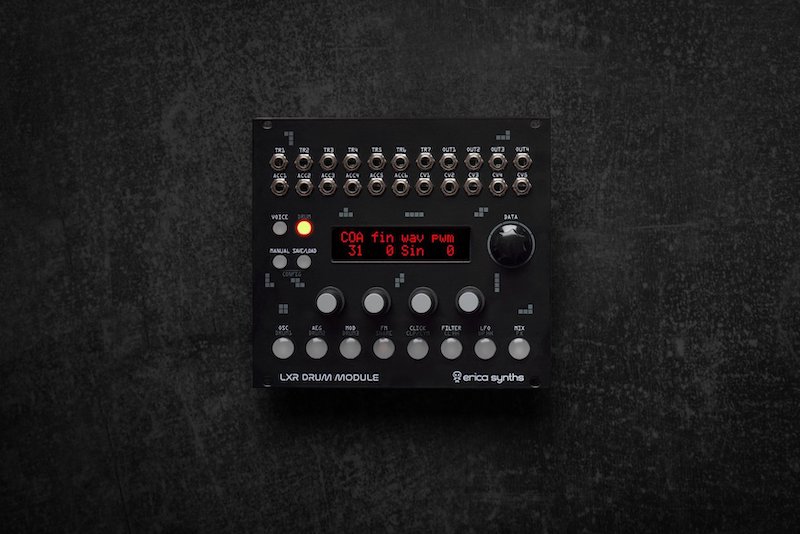
The LXR-02 Eurorack Module retains all of the brilliant sound-sculpting tools for designing chest-rattling kicks and basses, head-crushing snares and claps, and piercing cymbals and hats. Featuring six highly customizable voices with over 30 parameters per voice, the LXR-02 Eurorack Module features three user-definable drum sounds for not only creating kicks, toms, zaps, and transient machines, but also for melodic instruments like bass and lead synths with multiple waveforms, filtering, and loads of modulation. The other three voices are much more noise-oriented, with a dedicated snare voice, a shared clap and cymbal voice, and a rich hi-hat voice with separate control over triggering the closed and open hi-hats. All sounds feature insert effects for further taming or crushing timbres with distortion and sample-rate reduction as well as four assignable outputs for processing separately throughout your Eurorack system.
Where the LXR-02 Eurorack Module departs from its original state is the swapping out of hardware-based sequencing for full modularity for more user-definable control over the six voices. Although the user-interface and direct control features reflect heavily upon the original's, the LXR-02 Eurorack Module offers per-voice trigger and accent inputs for fully customizable sequencing, as well as five assignable CV inputs with 1V/Oct tracking capabilities for playing back full bass lines and pitched percussion to drive against knocking drums. With the ability to save and recall up to 64 kits on the removable rear SD card, the LXR-02 Eurorack Module is sure to be a hit amongst a variety of beat-driven modular artists as well as experimental ones. Just add a sequencer and you're off to the races.
Looking towards the SYNTRX II, we are met with a familiar layout inspired by the great EMS Synthi AKS, with digital matrix patching alongside a refined selection of controls and introduction to new capabilities. The full analog signal path with full onboard modularity made the original SYNTRX super exciting and customizable, and the SYNTRX II does not stray far—but instead enhances the range of capabilities and adds a nice touch of their industrial, blacked-out paneling with red accents.
Two variable-shape oscillators drive as the initial sound source, alongside a third definable modulation oscillator and a variable noise generator, producing hard sync, PWM, and much more with finer immediate control over octaves and fine-tuning. More modulation comes into play with the redefined random section with sample & hold capabilities, a ASR envelope generator + VCA combo, and even a ring modulator with selectable modulator source outside the matrix.
More modulation and audio can be combined with the onboard resources via two DC-coupled external inputs, as well as dedicated CV and gate inputs. The audio inputs sport one definable line/mic signal with phase inversion selection and another with flexible envelope following and comparator gate output capabilities. The onboard joystick lends itself to the playability of the SYNTRX II with definable X/Y depth as well as motion recording for personalized, looping modulation! The final touches of timbral shaping to note are the dual filter section that can run a low and high pass filter with variable resonance as one or both via series routing, and an onboard delay (replacing the previous model's spring reverb tank) works as a unique performative tool with "hold" and "add" actions.
Two pannable channel outputs with individual low pass filters offer a wide range of creating separate processes and mixes as well as feedback possibilities for complete chaos. The redesigned VU meter with switchable range monitoring and a scope out jack compliments the overall aesthetic with a hard contrasting digital matrix mixer with 254 available presets to flip sequential through or in any order. One of the quirkiest yet highly desirable features of SYNTRX II is the inclusion of a piano-roll style sequencer baked right into the functionality of the matrix mixer for creating wonderful pitch sequences to leave you other modulation inputs for more complex tasks.

And though not a new product, Erica has announced that the hotly-anticipated PĒRKONS HD-01 hybrid drum machine is finally open for orders...so all in all, it looks to be an exciting time over at Erica HQ!
Mamma Mia! That's a Hot Slice of BASTL Pizza!
Saucing up the modular scene with sprinkles of mozzarella modulation, BASTL Instruments has brought a tasty and digital complex oscillator to SuperBooth '22: it's Pizza.
Grab a slice or two of the magical and morphing sounds of three oscillators with brilliant and unique routing and flavor combinations. Starting with a clean and rounded base, Pizza offers a fantastic variety of toppings with two variable oscillators known as the Ratio and Octave oscillators, both providing variable waveshapes for blending square, sine, saw shapes…or anywhere in between! The Ratio oscillator offers several user-definable ratios while the Octave oscillator provides four different octaves to shift through. It not only has its own output, but also can be replaced via an external signal.
Where Pizza starts to cook lies in the shaping and FM parameters, offering a bipolar index amount of phase modulation from either of the two modulating oscillators or a blend dictated by the FM index. Circle up some spicy peppers with the ring modulation functionality, which behaves similarly to the PM/FM routing, and fold a nice slice with additional wave-folding control over the main oscillator. Add even more toppings with both the hard sync input for a crunchier crust, and the assignable control input to take control of a number of different parameters or serve as an external FM input.
One must also consider the balance that is struck between all elements, and Pizza understands this with a completely definable pitch knob for setting octaves, semitones, detune, and fine tuning across the oscillators—even the 1V/oct input calibrates and quantizes any CV input! With multiple CV inputs to supply additional help in making the Pizza perfect, you and your modular connoisseurs can bask in the flavorful and melting bliss of BASTL's cheesy and ooey-gooey Pizza.
4MS: Envelopes, VCAs, and Clocks Galore
Returning to their modular roots, 4MS comes to Superbooth with five new modules: three are part of a new EnvVCA line, and two are updates of classics from the company. Most of these modules are slated for release later this year in the Fall. Let's take a look at what they each have to offer!
A perfect companion to any sound source, the EnvVCA is a compact, analog EG/LFO with built-in VCA. Straightforward and to-the-point, a Rise/Fall slider pair each have independent rates, with a cycle button that can turn this into a linear LFO-like modulation source. Envelope durations can be as short as 12ms to as long as 20 minutes for everything from high-frequency to absolutely glacial modulation. Other features include an attenuator slider, CV inputs to trigger the envelope and toggle the Cycling behavior, and a Follow input that allows for Slew limiting. The VCA is a low-noise, DC-coupled circuit that works great for audio and CV signals alike.
Like its smaller sibling, the Dual EnvVCA is a compact, analog EG/LFO with built-in VCA—multiplied twice. Featuring all the same features as the EnvVCA, this version has dedicated Level and Offset knobs for the Env jack outputs. The VCA's CV input jack is also normalled to the Envelope output (defeatable by patching), and a shared cycling jack affects both channels. An analog OR output combines the peaks of both channels.
The Dual Shaped EnvVCA is a combination of the previous two modules, with some helpful additional features. Most notably, the Analog Waveshaping section, with CV input, smoothly transitions from exponential, to linear, to logarithmic without changing the envelope rate. A selectable Trig input lets you independently toggle the cycles, trigger the envelopes, or work with gates for an ASR envelope response. The Dual Shape EnvVCA also has a dedicated 5v linear output for each envelope channel.
A miniaturized, single-channel version of their classic PEG module, the Mini PEG gives you clock-synced envelopes and LFOs, variable shapes, clock divider/multiplier, and a dedicated 5v modulation output. A Cycle button with CV toggle easily produces an LFO-like response with a wide variety of tempo-synced shapes. Dedicated attenuverter and offset controls let you fine-tune the perfect amount of modulation. At 8hp, this PEG can easily slip into any smaller rack in need of tempo-synchronized modulation signals.
An improved version of the Shuffling Clock Multiplier and SCM Breakout, now combined into one module, is the final new offering from 4ms at this Superbooth: Shuffling Clock Multiplier +. This version has tighter timing and is perfect for creating complex rhythms with shuffle, slip, skip, and rotate controls for manipulation of clock signals. A jumper on the back lets you enable/disable the free-running internal clock. Pulse width, mute, and 4x fast controls round-out the features of this classic module facelift.
So, 4MS has clearly been quite busy—but we're thrilled to see them return to some of their earliest types of designs. As Eurorack was just getting started, 4MS made huge waves with designs like the PEG and various clocking utilities…and these seem like a next generation of all of these ideas, refined and ready for the future.
Xaoc Devices: Simple Utilities to Otherworldly Oscillations
Likewise, XAOC Devices comes in hot with 5 new modules for Superbooth: two expanders for their Leibniz subsystem, a triple summing mixer, stereo frequency shifter, and wonderful-sounding and quite novel analog oscillator. These aren't quite available for order just yet...but let's take a closer look at what they're offering.
Their second oscillator offering, Sofia is a quite complex and novel analog oscillator that uses a mixture of a warm saturated base tone and two modulating ripple elements, according to the manufacturer: combining to create a completely new, novel form of animated waveshaping. The front panel has numerous patch points that are designed to expand the sonic possibilities with self-patching. Capable of generating a vast array of sounds from wooden plucks to vocal growls, the Sofia is more than just an ordinary oscillator and feels like a full-fledged sound exploration device. It pairs great with a filter, but sounds fantastic with just a VCA—you'll discover that there's no need to hide all those bizarre new harmonics.
A component of the Leibniz subsystem, Gera allows masking individual bits of digital data with logical AND operation. 8 individual gate inputs affect the individual bits of data and 8 illuminated switches for manual inverting of each control input are the main vessels for control. When connected to a Drezno which is processing a waveform or voltage, masking of individual bits yields various forms of quantization. Bit processing logic in Gera is hardware-based, which allows for virtually no latency, and the binary signals can change at extreme rates.
Likewise, Poczdam is a binary data routing solution for the Leibniz subsystem that is particularly useful with complex Leibniz setups that need to reconfigure the data flow between multiple modules. It allows manual and remote switching between two Leibniz data sources, modifying individual bits of the data stream, and re-clocking the data with its onboard voltage-controlled wideband oscillator, or with any external clock signal. It can also be employed in small creative patches for waveform splicing, disrupting rhythmic loops, or generating digital chaos.
Shift your frequencies in stereo with the Koszalin. Two inputs take a stereo signal, or two mono signals, and spit out a pair of frequencies shifted down as well as up, giving you a total of 4 outputs. Featuring quasi-exponential and linear frequency change of +/-5kHz and full stereo feedback under voltage control, this is a sound manipulator's dream. With direct control of the feedback amount, routing and response, complex patterns can emerge, producing everything from pristine Thru-Zero FM'd shifts and gorgeous barber-pole effects to clangorously destroyed timbres and beyond.
Lastly, Sopot is a small utility designed for working its way into a stereo system. It features three summing sections that each have a single output and 4 inputs. Designed with premium opamps and soft-clipping circuit, you can drive the inputs for a nice breakup, or add a -12dB pad. The middle section can act independently, or it can feed the top and bottoms using the 3-position switches for 0%, 50%, and 100%.
Sofia and Koszalin alone seem like they'd make for a strong basis for an experimental, exploratory setup, and we're quite eager to try them out—and of course, the new utility found through the expansions to the Leibniz system will prove quite useful to those invested in that peculiar corner of the modular universe.
Powerful Eurorack Audio Utilities from Joranalogue
Joranalogue is back yet again with some stellar new Eurorack modules, adding both highly flexible routing and complex effect modulation for processing all your favorite modular signals. Starting with the smaller yet insanely powerful device, Joranaloge's Pivot 2 offers analog signal routing via two FX loops and a singular crossfader, pivoting from one routing to the next. Pivot 2's send and return sections actually intermingle with one another based on the position of the pivot control, putting them in series with one another on both extremes of the control as well as fully parallel when the control is centered at 50%. Brilliantly, Joranalogue added a CV input and attenuverter for modulating said pivot control to automatically crossfade at any rate for rapid and snappy or slow and smooth transitions.
Bringing forth one of the more unique modular delays on the market, Delay 1 is an all-analog BBD-based delay effect showcasing intriguing features to create stereo effects, inverted feedback, and much more. Clocked via an internal high-frequency VCO, the Delay 1 can be pitch tracked between a range of 1 to 50ms with onboard fine and coarse tuning to dial in the perfect effect. This pitch tracking goes hand in hand with the pluck input to create Karplus-Strong style voices (no audio input needed!), and the secondary time CV input can go as far as +/- 1V/Oct for counter-melodic movement for interesting and warped results. Tame or expand upon your effect with both damping and feedback control, each of which sporting a lovely modulation input as well as tone-defining features like the damping's filter (high/low pass) and the feedback's generation (inverted or in-phase). The standout feature of Delay 1 has to be the dual outputs for normal and phase-shifted takes on the blend control for creating large stereo images or even opposing comb-filter effects when dialed in just right.
These two in pair together could make for an excellent effects processing chain. And what's more, Joranalogue has announced that Step 8, the peculiar sequencer/sample and hold/track and hold bank shown at last Superbooth, has gone through some design revisions and is due to be put into production in the near future. None of these are available to order quite yet, but we're quite excited for the moment that they are.
Endorphin.es: Andrew Huang Collaboration GHOST + More!
Rolling into Superbooth 2022, Endorphin.es are presenting three modules this time around—two redesigns of prior modules, and one totally new multi-effects unit.
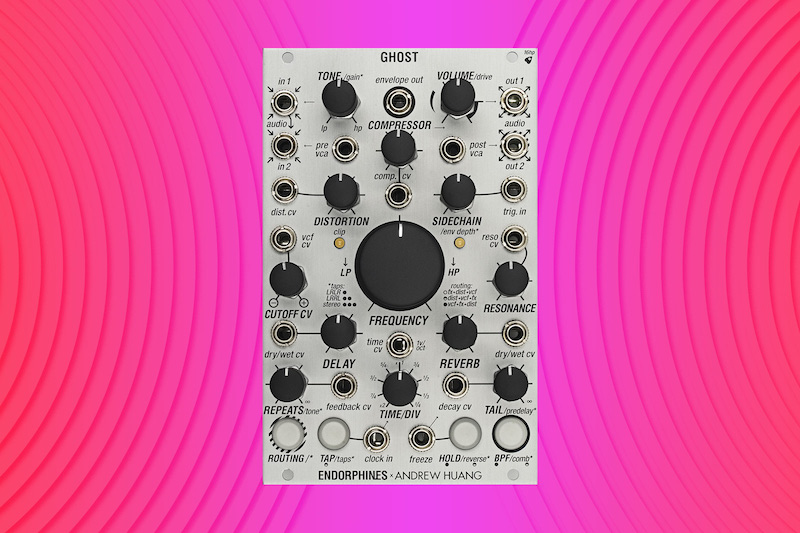
Starting with the new, GHOST is an extremely capable stereo effects processor designed in collaboration with the one and only Andrew Huang. With its state of the art ARM Cortex M7 processor, GHOST combines delay, reverb, distortion, and filtering into malleable effects blocks, all of which may be rerouted internally to conjure up a wide variety of sounds. There's also a one-knob compressor with a sidechain/ducking envelope, and pre and post-effect VCAs to shape your audio going in and coming out of GHOST. For more in-depth coverage on this module, check out our dedicated SIGNAL article on GHOST.
Airstreamer was notably absent from the recent silver panel rollout of Endorphin.es modules, but now it's clear why: Airstreamer 4 is slimmed-down redesign of their flexible envelope generator. This iteration of Airstreamer only offers voltage control of the Fall stage, but otherwise covers much of the same functionality from the previous version. Fire up some AD or ASR envelopes, LFOs, or coax T&H and slew limiter functionality out of this handy little friend.
Finally, the 1U craze continues with the conversion of the Running Order sequencer into the horizontally-inclined tile format. Pushing out two tracks of trigger sequencing, it's a great source for clocking, Euclidean patterns, performative rhythmic mutes, and much more. The two tracks share a clock source, but may be reset independently for interesting leapfrog-style sequences and polyrhythmic effects.
Step In and Out with Polyend's Play
Polyend has introduced a highly performable multi-track sequencer/sampler/controller named Play, offering eight sample and eight MIDI tracks for creating astonishing productions and live grooves. With a familiar look and elements of their lovely Tracker under the hood, Play offers an 8 by 16 grid for sequencing notes, CCs and parameter locks and automation, and loads of flexible tools such as tempo divisions, track lengths, and much more. The additional 4 by 8 grid to the right of the sequencer is built for several different tasks, including mute, solo, selectable parameter changes, and even variations—with up to 16 variations per track in one pattern. It is truly designed for live performance.
The onboard 3000+ sample library features immediate and great sounding samples, loops, and one-shots that can be further expanded through the SD slot on the back of the unit. Edit samples with filter, overdrive, reverb, and so much more. Edits can be destructive or non-destructive, allowing for on-the-fly, performative sample manipulation. Easily create pitch shifts, glitches, and delay throws for lively performances, and introduce wild sequencer changes such as step repeats, chance, and randomization throughout the steps.
128 patterns can be chained sequentially or on the fly, allowing for both planned and immediate action right from the user's hands. The MIDI channels can produce polyphonic data with a fully featured MIDI specification (including CCs and program changes), making for a highly versatile and programmable sequencer to accompany any instrument. Best of all, the Play is completely reliant on buspower via a USB-C connection, making it easy to take on the road with a power bank thanks to the lightweight nature of Play.
Curious to learn more? Be sure to check out our in-depth article on Play, where we discuss its inspiration and capabilities more deeply.
Left Foot Two Stomps…Bring it Back with Instruō's Cuïr and Làrachd
Flashy modules and synths are great and all, but expressive utility can be even more enticing for those of us looking to enhance our performances. Instruō has come to SuperBooth '22 with both a feature-rich and highly practical set of interfacing modules for bringing various signals and levels both into and out of your modular system.
With the many options for I/O in today's modular landscape, Instruō separates itself with not only supreme parts but highly innovative tools that are useful for a variety of scenarios. Looking at the first of the two new modules, Instruō's Cuïr is a balanced output module with independent level control over the mains and headphone outputs. Not only does it use high-quality low impedance differential drivers, but it also comes with a pair of high-end braided balanced cables to bring along to the studio or live gig.
Utility can be just as exciting as any other modular system, and Instruō's Làrachd proves that with the utmost flexibility in routing and use cases. It allows you to take other stereo, line-level signals and bring them into your system—either their sound directly or using it for modulation purposes via the onboard envelope follower and gate generator.
If you're lacking an extra synth or drum machine, or just wanna use the room ambiance as an audio or control source, an onboard condenser mic can also be utilized, with both input signals capable of being internally passed through the Enhance stage—offering variable waveshaping and limiting via one knob. For contouring your modular system, the input signals are also routed through an envelope follower section pre-enhancement, offering variable attack and release, linear or exponential response, and both positive and negative unipolar outputs.
Although you can have an automated gate signal via the threshold comparator for interacting with your modular, you can also get deep and personal with the included footswitch as well…which can plug right into the Làrachd for additional features. The pedal section not only offers human interaction through independent trigger and gate outputs, but the trigger output can have its length tuned for perfect response as well as a manual button for immediate response to the second gate output. Together, these modules serve as a stellar starting and ending point for any system with little space and power required.
Holy Jeepers It's a New OP-1 from Teenage Engineering
In addition to their recently-announced TX-6 Field Mixer, Teenage Engineering had more to show. Taking everyone completely by surprise, Teenage Engineering has introduced the OP-1 Field: a refinement/overhaul of the classic OP-1, designed to update to modern recording standards and, more importantly, to make it easier to get straight to making music.
Let's start by listing some changes to the physical specs. The OP-1 Field features a completely re-designed aluminum chassis, a new speaker system that provides surprisingly powerful bass performance, and a new high-resolution screen. It also features velcro pads on the bottom of the unit, used for attaching accessories like bags/cases...or for attaching the OP-1 to other stuff that's lying around your house (or, perhaps more practically, to the top of a larger keyboard). The OP-1 Field features USB-C connectivity, can act as a USB MIDI and USB Audio host(!!!), and can transmit MIDI and Audio directly via USB to many of Teenage Engineering's other products (TX-6, OP-1, OP-Z, etc.). The FM antenna now works for both receiving and transmitting...making it possible to take your (very limited range) DAWless lo-fi pirate radio station with you wherever you go.
The most striking changes, though, have to do with what's going on inside. OP-1 Field features an upgraded sound engine with 32-bit stereo audio throughout; and moreover, all of the sound engines have been updated with a new UX and new audio refinements to make them more easily navigable and better-sounding than ever before. Teenage Engineering has also added a new sound engine, Dimension: an analog-style synthesizer that was sorely missing from the original OP-1. Additionally, they've provided a new reverb effect called Mother.
The Tape section now feature eight swappable tapes—providing for completely new types of workflows overall. Moreover, they've included four distinct tape styles, making it much simpler to get straight to your desired sound quality...with multiple flavors of "lo-fi" on tap. Studio 4-Track mode allows for the clean, pristine recording of a reel-to-reel deck in its prime, while Vintage 4-Track mode imparts the saturation and warmth of older, somewhat neglected reel-to-reel machines. Porta mode emulates the sound of some of our favorite lo-fi cassette recorders, while Disc Mini mode captures the peculiar and distinct lo-fi tone of minidisk recorders.
Overall, there are too many updates to list here—but rest assured, this is much more than a facelift of the classic OP-1: it's a new generation of instrument with vast new capabilities. Moreover, it sounds better and is easier to use than ever before. This combined with the staying power of the original OP-1 means that we're sure this new device will have a lasting impact...and will probably spawn entire genres of new sounds altogether.
Get Down and Dirty with Finegear's The Dirt Magnet
With a complementary look to its older sibling The Dust Collector, The Dirt Magnet is yet another stellar-looking multi-processor for adding lovely inconsistencies and unique timbres to your sound.
Besides the quite familiar layout with individual blocks of processing and modulation capabilities, the most notable feature is the semi-open magnetic tape attached at the bottom of the unit: the heart of the flexible delay found on the right side of the unit. Not only can you design the tone, feedback, and spatialization of the delay, but you can also influence the speed of the tape and even get up close and personal for tape stop effects and manual movement over the tape itself.
Other internal modules to note include a band-passed noise section, a crackle generator, ring modulation, and a low pass filter, all of which have several tonal-shaping parameters and individual entrance and exit points on the rear. Additionally, all of the internal modules can work with Eurorack CV modulation along with the two onboard LFOs, each with sculptable waves, speeds, and other timing and shaping parameters for influence internally or externally. In short? You can do a lot with this thing, and if you're working with modular or semi-modular gear, it'll play nicely and add loads of lo-fi tones to your arsenal.
In addition to this wonderful studio processing tool, Finegear showcased an in-development mixer known as the ModMix, a CV-controlled console with what seems to be a highly flexible interface.
Integrating with Eurorack CV via 1/8" jacks, the ModMix features four channels of gain, three-band EQ, four auxiliary sends, volume, and panning. Onboard modulation controls with envelope followers and LFOs make for amazing modulation sources to the individual channels' panning, volume, and send amount. Additionally, the mono send and stereo returns have quite flexible leveling and routing options, with all connections being made on the rear, and independent headphone and master outputs make this not only a stellar studio device but also amazing for complex live setups. Although its modular nature makes it fit well with Eurorack devices for extra control and automation, the ModMix will surely be a creative mixing option for any style of setup with loads of onboard and modulate-able control.
We're not sure just yet when Dirt Magnet and ModMix will be available…but we certainly have our eyes and ears open.
Two Steppin' with ALM's ASQ-1 Sequencer
ALM has truly been hitting it out of the park with their fantastic releases from the past year, including the Tyso Daiko and MFX providing loads of timbral brilliance for creating full-voice percussive elements and loads of effects processing, respectively. However, this Superbooth ALM brought out another big player for their arsenal of great-results out-of-the-box modules with the new ASQ-1, which has us all pretty excited.
ASQ-1 is an SH-101 style sequencer with two independent channels of gate and CV outputs alongside loads of functionality for creating highly performable patterns. Along with your typical step/rest/hold input for this type of sequencer, you also have customizable pattern lengths per track, over-dub capabilities, and even a play mode to play in additional notes or transpose the sequence. Along with clock and reset inputs, the ASQ-1 sports four trigger inputs for selecting different patterns for full-length song creation. And check out those buttons—it looks like they came straight off of a mechanical keyboard. That's sick, and we're ready to get our click-clack seq attack going.
While ASQ-1 seems more or less finalized, ALM also shared a couple of teasers that have no expected dates or production as of yet. The first is Mega-Tang, what seems to be a four channel stereo mixer with independent CV control over channel levels as well as a mono send and stereo return with individual send amounts. The other teased module is Mega Milton, which appears to be an expanded version of the exclusive Milton module from their beloved System Coupe, offering new features like stereo line to Eurorack-level, slew limiter, and S&H circuit with a noise output.
We're not quite sure when ASQ-1 or these teased modules will be available—but we're still quite excited for them, nonetheless.
Refreshed and Revived with Ritual Electronics
Known for their occult and brooding artwork and module options, including modulation, coloration, and utility, Ritual Electronics pulled out all the stops this year showcasing two new modules alongside two updates to a couple of 3U modules in their current catalog.
Focusing on the updates first, Ritual Electronics has brought forth an improved version of their beloved dual function generator, Anima. Although the physical appearance is quite minimal in change, the functionality has improved quite a bit with a split in the EOC output for instead both end of attack (EOA) and end of decay (EOD) for each function. Additionally, the uni/bipolar switches have been replaced with LED buttons that the cycle functionality has shifted to, with CV input to modulate the cycle state expanding the AD/ASR nature of Anima. Another update comes in the form of the Miasma expander, Crime, coming down from two diode combination options to one with an expanded low and high pass filter option for series sculpting applied to your feedback path as well as an individual output bypassing Miasma's blend.
New to their collection includes Aranea, a 3U matrix mixer, Ruissellement, a 1U shift register, and Division, a 1U resettable clock divider. Aranea offers a five-by-five layout with unique I/O capabilities as well as phase mixing. Each of the five inputs can be mixed down to one of the five outputs (A through E), with each one featuring a polarizer to shift to either full in-phase or fully inverted (with a nice center detent on each node). All inputs and outputs are DC-coupled, making it just as useful for mixing audio signals as much as CV. Along with a full mix output, the individual outputs are paired with interesting combo outputs of A+B as well as D+E, and the two slash outputs are placed directly between B and C as well as C and D, something that might be indicative of either or combinations of paired or multiple combination outputs. Regardless the details, given Ritual's past alignment with particularly brutal sonic processes, we're sure that Aranea will prove to be an intense noisemaker's feedback dream.
Moving on to the 1U additions, Ruissellement is a shift register module with a collection of gate and CV outputs. Feeding a clock into the Ruissellement will split it amongst eight gate outputs moving in order with an additional reset input for resetting the gate pattern. We can only make assumptions about its functionality—but the layout strikes us like something of an expanded Rungler: the XOR logic at the input and combination of "odd" and "even" CV outputs make us suspect that this is intended to produce a combination of pseudo-random gate and CV sequences. If that's true, then we're quite excited.
The second 1U module introduced was a clock divider known as Division, simply offering six divided outputs ranging 1/2 to 1/64 the speed of the incoming signal with a reset input to introduce complexity for rhythmic sequencing. As of yet, we're not quite sure when these will be released—but there's certainly a lot to look forward to.
An Unexpected Instrument from Eventide: Misha
Eventide has previously dipped their toe into the world of Eurorack with the EuroDDL module and they're back in it with Misha. Instead of an effects processor, they bring us a unique sequencer based on tone rows—a technique used by serial composers—that focuses on the use of sets of intervals rather than specific notes. With a pleasing V-shaped interface and central screen, this is designed to be a central fixture of your rack.
It's designed to fit your needs with the ability to generate sequences, sure, but it can also produce audio and be played with MIDI. Musical keyboards work, of course, but Misha also has support for QWERTY keyboards, so those mechanical beauties now have a reason to be part of the on-stage ambiance. Out of the box, 100 factory scales are loaded, and it offers Scala support, giving you the option for just about any type of pitch set, tuning, or mode you could imagine.
Playability seems to be paramount with 4 assignable buttons and a luscious V-shaped button pattern that is made for real time manipulation of the sequence. With top-mounted jacks, it can also easily be mounted in the bottom row of a case and no cable clutter should exist. Misha can function as a capable polyphonic MIDI sequencer, too, or if you have a large enough rack, capitalize on the three CV outs for Eurorack polyphony.
Misha is slated to be available this Summer, priced at $599.
Random*Source: 50th Anniversary Serge and More
Random*Source is back this year with a host of insane new goodies. Now, here's the thing—most of us here at Perfect Circuit are big Serge fans; and as such, we've been keeping a close eye on their progress over the years (heck, a couple of us even have R*S systems, ourselves). This year, they seem to be answering a number of our prayers in one fell swoop: they've brought a reimagined 4U Paperface system, a voltage-controllable Resonant Equalizer, and an all-in-one 3U system. Let's take a quick look at each.
Random*Source has been making 4U Serge systems for a number of years now—primarily focusing on refinements of Serge's designs from the late 1970s and early 1980s. These are what many know as the "classic" Serge circuits—modules ranging from the New Timbral Oscillator and Wave Multipliers to the Dual Universal Slope Generator. However, in recent years, there's been a resurgence of interest in some of Serge's earliest designs...commonly known as "Paperface" designs from the early 1970s. These circuits often have a considerably more raw, crude, unrefined, and brutal spirit than their later counterparts...and they're a heck of a lot of fun.
Random*Source is presenting a "50th Anniversary" Serge system comprised of 21st-century re-imaginings of these earliest designs in the original 4U format. The panels they showed included some of the most crucial parts of early 1970s Serge systems, including the 1973 Oscillator, Smooth and Stepped Function Generator, Triple Processor, Triple Waveshaper, 1973 Filter, Sequencer, Programmer, Triple Bi-Directional Router, and Peak & Trough. According to their own social media, these aren't just copies of the original designs—they include a number of modern refinements, from 1V/Oct tracking on the oscillators to new performance features on the Programmer modules. We're not sure quite yet whether this will be a continued series, or if the system they showed represents the entirety of their plans for this revival of the Paperface designs...but either way, it's quite exciting to see them give attention to these often-overlooked modules. Early Serge systems are very special instruments, and I'm thrilled to think of what one could do with these revisited designs.
Random*Source also showed some other new modules: a 4U half-panel Programmer, 4U half-panel voltage-controllable Resonant Equalizer (Serge nerds rejoice!), and—quite interestingly, a 3U/Eurorack self-contained full panel. The full, standalone Eurorack panel contains a Precision VCO, Dual Universal Slope Generator, Wave Multipliers, SSG, Mix/Noise, Variable Q Filter, Xfader, and what appears to be an output/power module all behind a single panel. If you're looking to get into Serge, this is a quite amazing setup reminiscent of the classic Animal panel; we're sure that, when available, it will prove an excellent entry point for many into the bizarre universe of Serge designs.
Buchla: 200 Series and New Easel Program Manager
Speaking of peculiar 4U modular systems, Buchla is back at Superbooth as well—showing a number of new products. Most visible among these is their recent outpouring of new modules modeled after the original 200 Series—bringing users a long-requested revival of these 1970s designs to modern users. Buchla announced the release of several pivotal 4U 200 Series modules earlier this year—the 258 Dual Oscillator, 281 Quad Function Generator, 292 Quad Lowpass Gate, 266 Source of Uncertainty, 207 Mixer/Preamplifier, and 257 Dual Voltage Processor have been available for order directly from Buchla for a short while already. These modules were all developed in collaboration with Roman Filippov, who famously went to great lengths to produce DIY clones and work-alikes of many Buchla 200 Series modules in the 2010s and onward—creating a significant resurgence in interest in these iconic designs.

A close look at their demo system reveals some additional cult favorite modules—notably, the 248 Multiple Arbitrary Function Generator (MARF) and 288 Time Domain Processor. Now, given the complexity of the original MARF and the outright impossibility of building an exact recreation of the original 288 (which only ever existed as a prototype)—and given the fact that Filippov's past independently-produced "clones" of these modules are microprocessor-based—we don't expect these to be 1:1 replicas of the originals, but rather modern re-imaginings that emulate the workflow, behavior, and sound of the originals. That said, a MARF and a 288 are spectacularly fun and interesting modules, so we're sure that these will prove to be a blast, despite the perhaps-unavoidable design departures from the original circuitry.
We note that Buchla was also showing a new "program manager" card for the 208c, Easel Command, and Music Easel. We don't have a lot of details at this time, but this is indeed an exciting prospect: on the 2013 model of Music Easel, the iProgram Card was used to recall user-definable presets and handle OSC control of the Easel's parameters.

It's not clear exactly yet how that functionality will translate on the modern card—but we have high hopes that this will prove a fun and powerful option for recalling Easel presets, doing extensive computer-based remote control, and more. Fingers crossed that we'll see these in the wild soon!
…and It Will All Come Back to Soma's Terra
We're on a roll talking about bizarre esoteric synths...so let's keep going! Everything that SOMA Laboratory creates seems to change the way we look at creating music, but somehow they really flipped everything on its head with their reveal of Terra.
Terra itself is designed around a slice of a tree's trunk, bursting with gold and silver tactile controls placed with a spread layout that seems to mimic the span of a human hand. However, at its core, Terra is a polyphonic synthesizer with microtonal tuning that is as accurate as 125 increments across a single semitone—with the total range of a grand piano. This is achieved not only through individual note tunings via the 12 gold capacitive bumps, but also via combinations of four additional sensors, offering 16 different variations of keyboard transposition. Along with these pitch-shifting sensors, Terra showcases four dynamic sensors for timbral and amplitude modulation as well as two hold sensors.
Terra itself houses modulation similar to an accelerometer via a three-axis motion sensor, offering full human interaction to create sonic depth beyond the onboard controls. The sound itself can be crafted in a number of ways thanks to the 32 complex digital synthesis algorithms as well as a stereo built-in effects processor for ready-to-go sounds right out of the box…or should we say, right out of the slab? 96 presets are readily available to recall, and with no major screens or menu diving, Terra takes the mundane and soul-sucking parts of programming a synth out of the question so you can perform and create with no technological hang-ups.
Currently, Terra is a concept/prototype only. It will be interesting what comes of such a brilliant and unique instrument—both for its own sake, and for future SOMA products.
Verbos Electronics: Polyphonic Envelope
Performative and sequenceable modulation is already hard enough to come by, and the lack of innovation in basic CV modulation sources such as envelopes and LFOs leads to oversaturated amounts of basic tools. Now, Verbos has hit the scene time after time with solid, flexible, and creative modules that can not only spice up your Eurorack, but also work well for those looking for expanded options for control. The reveal of their new Polyphonic Envelope is another great example of their ingenuity.
The Polyphonic Envelope contains four separate envelopes connected to a single shaping and staging interface that is highly performable and modulate-able. In classic Verbos fashion, the Polyphonic Envelope is packed with multiple inputs for varying the signal over time, several trigger outputs tied to multiple events, and even an "all" section for a dense and compounded signal. All four of the Polyphonic Envelope's EGs share attack, hold, and decay stage controls (with CV inputs!). Envelope 1 offers dedicated stage pulse outputs for use elsewhere in your system as well.
Each "voice" can be triggered or gated via the individual gates as well as the cascade trigger button and input, playing each voice sequentially after one another based on the selected mode. These modes include the end of hold and decay stage as well as the end of the entire envelope, making for a nice set of shorter or longer EG cascades, great for routing to many destinations in your patch. What makes the Polyphonic Envelope so dynamic and lively, though, is the inclusion of skewing at the bottom of each stage, providing a way to create macro variations for all envelope outputs relative to one another. Similarly, there is a level tilt section of the module for creating amplitude changes for each respective envelope output. Sporting pulse trigger outputs for the end of each envelope, the all envelope, and the endless possibilities of peculiar cascaded modulation, we are very excited for the Polyphonic Envelope to be ready for release!
Controllable Outbursts: AJH Multi-Burst Envelopes
AJH brings their unique burst generator to Superbooth, the Multi Burst Envelopes. Unlike most burst generators, which purely produce bursts of gates, this unique Eurorack module offers selectable burst envelope shapes, giving you interesting tonal and modulation possibilities.
Select a sequence between 1–40 bursts in length and move between eight envelope shapes. Pulse width and slope are volage-controllable, and the internal LFO can control the repeat time of individual bursts. Use the internal clock, or trigger a cluster of bursts: you can let this module drive your modulation chain, or react to it. Envelope shapes are CV controllable, letting you dial in some strange movement, and two modes change the behavior of the Trigger input. One-shot mode plays the entire sequence after receiving a trigger input, and Rettrigger mode will start the beginning of the sequence whenever a trigger is sensed. That means countless ways of creating flurries of rhythmic modulation…sounds right up our alley.
Reshaping modulation and changing your typical view of burst generation, the Multi Burst Envelopes module is available for preorder now!
Tiptop: Buchla 200T Update + Black Mantis Case
Tiptop Audio showed up in full force, with entire systems in tow—including original Tiptop Designs and a full system of their Eurorack adaptations of Buchla 200 Series modules.
We were hopeful that Superbooth might yield the announcement of a release date for the next batch of Tiptop/Buchla 200 Modules—but it seems that there's still likely to be a wait. We've been enjoying our 258T Dual Oscillators and 281T Quad Function Generators, but we've been vying for some new friends for them to play with. Happily, it seems this won't be too far off—the 245T Sequential Voltage Source and 257T Dual Voltage Processor are still due for the coming months. And—great news—it seems that Tiptop is having great success in manufacturing their own vactrols, a key component in the design of the quite-important 292T Quad Lopass Gate. The 292 is a significant part of the Buchla 200 Series sound, and it seems that, at long last, that sound will soon be attainable for Eurorack users: 292T's design is complete, and it is expected to ship late summer of this year.
Outside the realm of Tiptop Buchla Modules, however, we were delighted to find another surprise at Tiptop's booth: a black version of their highly-regarded Mantis powered Eurorack case. Since its introduction several years ago, the Mantis has proven to be perhaps the best value of all Eurorack cases, provided a robust power solution with a road-worthy design at an excellent price. While its original pale color certainly has its own charm, the increasing number of black-paneled modules out there has increased the demand for a matching all-black case...and finally, Tiptop has obliged.
We're confident that this case will be a hit, and all you black-panel-only folks can sleep at night knowing that soon, your new favorite case will arrive. The Black Mantis case is available for preorder now.
Four New Modules from Shakmat
Shakmat brings us four new modules that all look quite handy. The first one was teased last September…and the Banshee Reach has been slightly redesigned after feedback. This 8HP analog VCO is designed to be playable, and to that end, an incredibly delightful feature is the tuning lock. An Octaver switch locks the Fine tuning knob and turns the Coarse knob into an octave switch, which gives you 9 octaves of transposition. A Sub generator, variable Shape control, and through-zero modulation make this a very attractive option to throw in any rack.
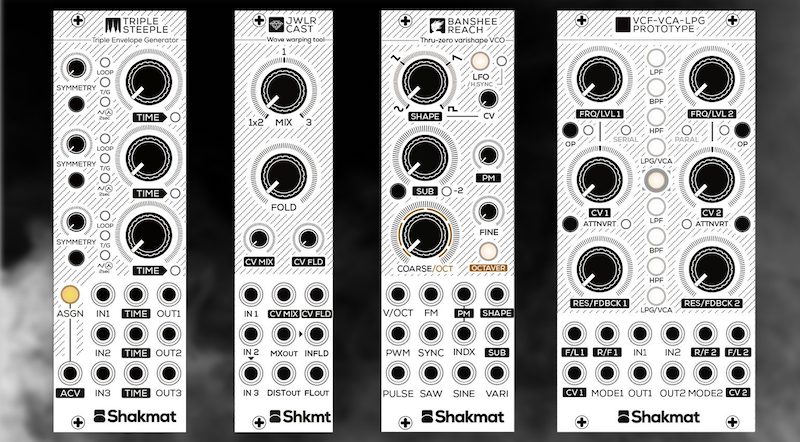
The Jeweler Cast is a compact sound-shaping utility in 6HP. It can function as a triple source mixer, distortion, wavefolder, and diode ring modulator. Mash and morph audio as well as CV signals for interesting, complex waveforms. Their triple envelope generator, Triple Steeple, seems like a great pairing for the Jeweler Cast. With the ability to work in 5 different modes—triggered, gated, looped, gated loop and clocked loop—interesting modulation will not be a problem. Timing of the envelope is CV controllable and a shared, assignable CV input for either the Symmetry or Amplitude is available. Internally normalized end-of gates are routed to channel three making experimental modulation possible.
Rounding out their offerings is a yet-to-be-named 12hp VCF/A/LPG which looks like a great option for adding analog feel via the signal chain, but with digital control. Two channels give you an MS-20 style LP/HP filter, LPG, and is perfect for stereo processing. All of these modules seem like they could find their way into any rack, especially since most of them are fairly compact and offer a good variety of options.
Fred's Lab Manatee: a Friendly Beast of the Sonic Sea
Offering an experimental, still-in-development device, Fred's Lab presents the Manatee, a unique spectral synth engine developed from scratch. It's not a virtual analog, not a wavetable, not FM, but something completely different. Since it's still in development, full features aren't available and are subject to change—however, it's inspired by the "...golden era of digital machines with personality..." and is a 3-part, 9-voice multi-timbral spectral synthesizer.
Designed to walk the line between additive and wavetable synthesis, the Manatee also uses a real-time resampler. A sub-oscillator and filtered noise sources let you dial in the right amount of tonal sauce for your application. Excelling at lush pads and bell tones, you get a solid amount of modulation options with two envelopes, LFO, and two spectral modulators. Indeed, this compact metal box is built solid and uses high-quality components. While this is not in production, a Kickstater is in the works for a limited-run initial production.
Clutch Drop from Gamechanger: Motor Synth II
The Motor Synth was a crowdfunded project that received an amazing response, and this year Gamechanger Audio presents a refined MKII version. Using electro-magnetic induction, the Motor Synth generates sounds and frequencies from small motors to create a very unique sound. This version adds an additional third digital voice to pepper into the unabashedly raw sound of the Motor voices and can produce classic waveforms or be used as a noise source. This digital oscillator also has its own amp envelope and 4-mode filter with a portamento setting.
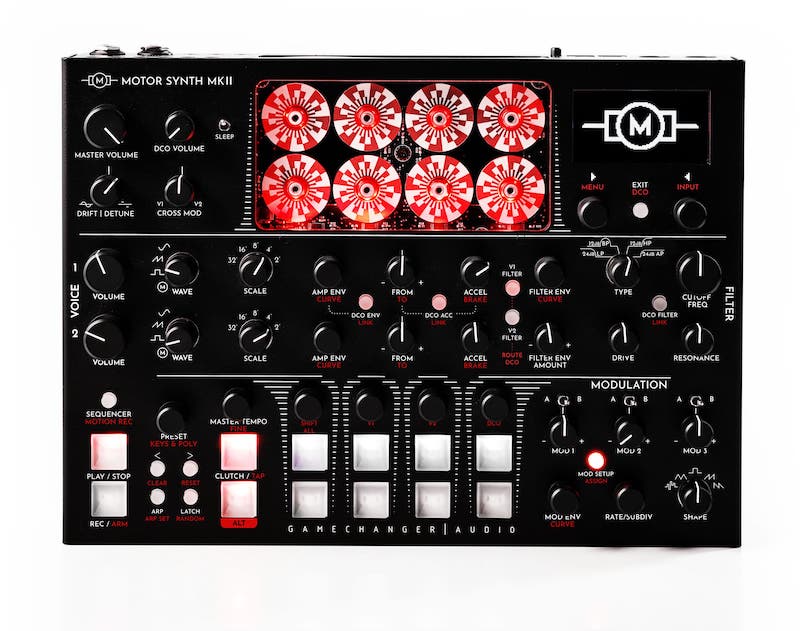
Stereo spatialization is an option, too, to a single 1/4" output (configurable to run as mono or stereo), using a TRS cable. The digital voice can be routed to either one or both outputs. Customize your sound with an added detune option and modulation section. Still with the same performable keyboard and sequencer, the Motor synth refines an already brilliant idea. The Motor synth is expected to be available later this year.
Unbeatable Grooves with Making Sound Machines Stolperbeats
Having been in development for quite some time now, Stolperbeats from Making Sound Machines makes way at Superbooth 22—bringing classic and underappreciated grooves and swing feels to the modular marketplace.
Offering six channels of percussive trigger outputs, Stolperbeats is here to provide that classic drunken vibe in variations of swing categorized under Clave, Push, Shake, and Dilla, as in the infamous J. Dilla that influenced hip hop and so many of today's modern genres. Each track offers a variety of sequenced grooves that can be layered via the kick, snare, and four other tracks, including two hi-hat and two percussion outputs. Each track can be CV modulated as well as the shuffle amount and groove bank.
Along with programming your beats in a sloppy and wonky sequencer, the Stolperbeats offers MIDI I/O for synching to other MIDI devices in your setup as well as sending out these feels to drum machines and synthesizers. You have extra sequencer controls such as subdivision and even synchronization to internal and external clock sources, and if editing the sequences on the device isn't your style, you can even edit via a txt file on your computer from the onboard SD card. Let your drums trip over themselves with Stolperbeats, coming to a modular market near you.
Relevant Routing with Doepfer's A-121s Stereo Filter + More!
Doepfer's newest collection of modules hits the scene with high levels of functionality and creativity, offering a stereo multimode filter and two four-channel mixers. Starting with the latter two, Dopefer brought out a simple yet highly practical quad attenuator known as the A-183-5, acting completely passive for no-noise mixing and power-saving proficiency. Although not the most exciting module, the usefulness of four channels to mix down at a compact size of 4HP makes for an easy way to close out your modular system or slide in to replace your chunkier power-hungry ones.
The second mixer, the A-138j, is a bit more complex in nature and actually provides a high level of complex routing for being a great centerpiece for audio and CV summing. Providing four individual channels, the A-138j offers attenuators and signal polarity switches per channel with a third mute option to take signals quickly out of the mix. Combining multiple signals and introducing inversion can not only create phase cancellation but can be good for creating phase-shifted sounds and modulation to create new waveforms and modulation sources. Each channel is routed to the dual main mix output and can be taken out when used solely with its corresponding Single Out A jack, and channel's one and two can achieve the same result but not break the normalization to the mix when using Single Out B.
A-121s, the previously mentioned filter, provides two identical multimode filters to be used in series, parallel, or stereo processing with independent signal inputs and normalization to input one. A main cutoff control in its glorious larger form sits atop the controls and jacks with both filter type options sitting to its sides, presenting a variable state that morphs between low pass, notch, band pass, and high pass. Easily offset each filter's cutoff to the main frequency via the SFM controls that act as polarizers when CV is introduced, and similarly the CFM control is purely meant for introducing CV with a shared polarizer to both filters. Not only can you influence the frequency information left by each filter but also the frequency difference between the two filters via the manual delta F control and independent CV input with dedicated modulation attenuverter. You can even customize modulation options over the filter type and resonance amount via internal jumpers with dedicated attenuators that act as voltage offsets when no CV is introduced.
Double Your Patches, Double Your Fun with La 67's DADA and MODii
La 67 brings double the dual modules with DADA and MODii, a two-channel VCA/VC saturator and a dual VC modulator, respectively, each with a high degree of flexibility in shaping your modular system. The DADA acts quite differently than your typical VCA with it featuring both a positive and negative input for creating unique timbres and phasing opportunities. On top of that, you get both linear and exponential CV inputs for double the amount of amplitude modulation, and the saturation side of DADA provides symmetrical clipping both positively and negatively.
Looking at MODii, La 67 offers a stellar dual modulator showcasing two completely different uses for applying envelopes, LFOs, random CV, and so much more. The two sections seem to share a gate function in both directions, but looking solely at the top we have a general function generator with attack and decay positioning as well as shaping for the response time. The Duration control can either apply sustain via internal gating or an external source next to the trigger input, and the function can act as a one-shot or cyclical one much like a unipolar LFO. Onboard time-response shaping of the A section makes for smoother and snappier shapes as well as an end of attack output for triggering elsewhere throughout your patch. The B section of MODii offers a variable gate/trigger delay as well as a sample and hold circuit for sampling the above function generator for varied modulation out of a single source.
Instant IDM For All: Mystic Circuits IDUM
Though it was techincally released a few weeks before Superbooth, Mystic Circuits still made the trip out to Berlin this year to show off their latest Eurorack module: IDUM. Cheeky name aside, IDUM sports eight different modes to process triggers traveling throughout your modular system. The result is instant IDM—it says so right on the panel!
IDUM may simultaneously process up to four different streams of triggers, while also accepting a separate clock signal. The probability of any gate manipulation occurring is determined by the Chance slider, with its duration set by the Length slider. Plus, these parameters, along with the Mode selection, the Loop switch, and a general Param knob are all open to voltage control for maximum patch interactivity. Between the eight modes, it's possible to achieve everything from burst generation and trigger delays to rerouting channels and turning gates into breakbeats. All in all, IDUM helps you save your brain power by adding the "intelligence" to your dance music for you.
Prism also showed Ruins, a quad lo-fi video oscillator, as well as 3DVCA, a quad VCA full of wild new tricks. We look forward to hearing (and seeing!) more about these as details emerge.
Superbooth 2022: What a Ride
Superbooth was crazy. There were plenty of other companies showing new gear—Klavis, for instance, showed Grainity (an analog "granular filter"), Tweakers (a modulation source), and Two Bits (a dual logic module). Syntonie, a recent favorite company among several of us at Perfect Circuit, showed new products, including a new input module for Eurorack video synthesis systems; Dreadbox showed a number of new DIY devices, Patching Panda shared their new Particles module, and Noise Lab showed Formantic (a wild new formant filter with an adorable joystick built in). The list goes on!
Beyond designers we've known for a while, Superbooth also had a showcase of bizarre, esoteric, and quite boutique instruments—Simple (an amazingly flexible DIY instrument design platform from Synth UX Academy), Landscape's Noon passive drum machine (which is amazing!!!), the Knifonium tube synthesizer, Silhouette Eins (an optical synthesizer that uses cameras, a light table, and image manipulation to create sound!!), a bizarre new synth from CG Products, Playtronica's Orbita (an optical instrument based on placing objects on a rotating turntable-like apparatus). We can't possibly list everything—but in short, it was a thrilling and inspiring experience that left us excited for everything to come in the world of synthesizers.


